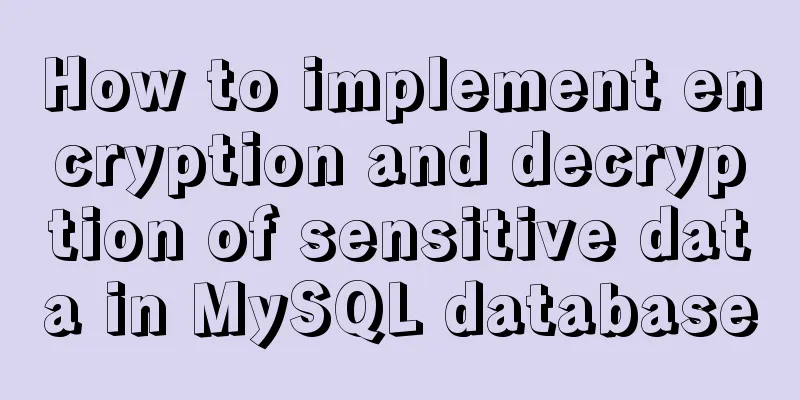How to implement encryption and decryption of sensitive data in MySQL database

|
With the advent of the big data era, data has become one of the most important assets of an enterprise, and data encryption is also an important means of protecting data assets. This article mainly demonstrates some simple ways of data encryption by combining learning MySQL functions and Python encryption methods. 1. PreparationIn order to facilitate subsequent comparison, data sets of various types are stored in different tables. Create a table of original plaintext data /* Create the original data table */ CREATE TABLE `f_user` ( `id` int(11) NOT NULL AUTO_INCREMENT, `name` varchar(50) DEFAULT NULL, `tel` varchar(20) DEFAULT NULL, `pwd` varchar(50) DEFAULT NULL, PRIMARY KEY (`id`) ); /* Add new raw data */ INSERT INTO `f_user` VALUES (1,'Cao Cao','10000000000','Cc@123'),(2,'Guan Yu','21000000000','Guanyu@21'),(3,'Liu Bei','20000000000','LB#200000'); Creating MySQL Encrypted Tables CREATE TABLE `f_user_m` ( `id` int(11) NOT NULL AUTO_INCREMENT, `name` varchar(200) DEFAULT NULL, `tel` varchar(100) DEFAULT NULL, `pwd` varbinary(255) DEFAULT NULL, PRIMARY KEY (`id`) ); Creating a Python Encrypted Table CREATE TABLE `f_user_p` ( `id` int(11) NOT NULL AUTO_INCREMENT, `name` varchar(200) DEFAULT NULL, `tel` varchar(100) DEFAULT NULL, `pwd` varchar(500) DEFAULT NULL, PRIMARY KEY (`id`) ); 2. MySQL encryption function method2.1 MySQL EncryptionInsert the data in the plaintext table into f_user_m, and encrypt and store the pwd password field. Remember the encrypted string because this value will be used when decrypting. /* Encrypted password field */ mysql> insert into f_user_m (name,tel,pwd) select name,tel,AES_ENCRYPT(pwd,'MySQL') from f_user; Query OK, 3 rows affected (0.00 sec) Records: 3 Duplicates: 0 Warnings: 0 The stored results are as follows
Note: If the encrypted data is directly stored in a varchar type field, the following error will occur:
There are three ways to handle this: 1) The encrypted data must be stored in a binary field such as varbinary/binary/blob in the utf8 character set, so the type of the password field in the above text is set to varbinary type 2) You can use the HEX() function to convert the encrypted data into hexadecimal format and store it. When retrieving the data, use UNHEX() to process it before decrypting it. 3) Use latin1 character set to store directly in varchar type field, but it is not recommended There are three ways to test and handle it yourself. 2.2 MYSQL DecryptionFor encrypted data, you can use the MySQL decryption function AES_DECRYPT to decrypt and view the plain text mysql> select name,tel,AES_DECRYPT(pwd,'MySQL')pwd from f_user_m; +--------+-------------+-----------+ | name | tel | pwd | +--------+-------------+-----------+ | Cao Cao | 10000000000 | Cc@123 | | Guanyu| 21000000000 | Guanyu@21 | | Liu Bei | 20000000000 | LB#200000 | +--------+-------------+-----------+ 3 rows in set (0.00 sec) The data viewed at this time is consistent with the plaintext table. 3. Python base64 encryption method3.1 Encryption using Python’s encodestring methodWrite a python script to encrypt the data and insert it into the table
#!/usr/bin/python
# coding=utf-8
import pymysql as mdb
import base64
sor_conn = mdb.connect(host='127.0.0.1',port=3306,user='root',passwd='Root@Py123')
sor_cur = sor_conn.cursor()
v_sql = "select name,tel,pwd from bak_db.f_user"
result_tb = sor_cur.execute(v_sql)
t = sor_cur.fetchall()
for col in t:
v_name = col[0]
v_tel = col[1]
v_pwd = col[2]
v_pwd = base64.encodestring(v_pwd) # Encryption v_sql_insert = "insert into bak_db.f_user_p(name,tel,pwd) values('%s','%s','%s');" %(v_name,v_tel,v_pwd)
sor_cur.execute(v_sql_insert)
sor_conn.commit()
sor_conn.close()The encrypted data is as follows: /* The encrypted data is as follows*/ mysql> select * from f_user_p; +----+--------+-------------+---------------+ | id | name | tel | pwd | +----+--------+-------------+---------------+ | 1 | Cao Cao | 10000000000 | Q2NAMTIz | | 2 | Guan Yu | 21000000000 | R3Vhbnl1QDIx | | 3 | Liu Bei | 20000000000 | TEIjMjAwMDAw | +----+--------+-------------+---------------+ 3 rows in set (0.00 sec) 3.2 Decryption using Python's decodestring methodThe decryption method uses base64.decodestring method, which is relatively simple and can be tested by yourself. Note: This method does not use an encryption string for encryption and decryption, so the security is relatively low. Therefore, you can continue to use another method. 4. Python AES algorithm encryptionThe AES algorithm requires the Crypto.Cipher module. This method is similar to the MySQL method. You can customize the encryption string, and the corresponding encryption string may be used during decryption, which is relatively secure. You need to install Crypto before use
The test procedure is as follows:
#!/usr/bin/python
# coding=utf-8
from Crypto.Cipher import AES
import pymysql as mdb
from binascii import b2a_hex, a2b_hex
import sys
sor_conn = mdb.connect(host='127.0.0.1',port=3306,user='root',passwd='Root@Py123')
sor_cur = sor_conn.cursor()
class PyDbString():
def __init__(self):
self.key = 'pythonkey2020320'
self.mode = AES.MODE_CBC
def addString(self, text):
cryptor = AES.new(self.key, self.mode, self.key)
length = 32
count = len(text)
add = length - (count % length)
text = text + ('\0' * add)
self.ciphertext = cryptor.encrypt(text)
return b2a_hex(self.ciphertext)
def desString(self, text):
cryptor = AES.new(self.key, self.mode, self.key)
plain_text = cryptor.decrypt(a2b_hex(text))
return plain_text.rstrip('\0')
v_strpass = PyDbString()
v_sql = "select name,tel,pwd from bak_db.f_user"
result_tb = sor_cur.execute(v_sql)
t = sor_cur.fetchall()
for col in t:
v_name = col[0]
v_tel = col[1]
v_pwd = col[2]
print(v_pwd)
v_pwd = v_strpass.addString(v_pwd) # Encryption v_sql_insert = "insert into bak_db.f_user_p(name,tel,pwd) values('%s','%s','%s');" %(v_name,v_tel,v_pwd)
sor_cur.execute(v_sql_insert)
sor_conn.commit()
sor_conn.close()View the data as follows:
The decryption method can be to change addstring in the above example to desString. The above three methods are used to encrypt and decrypt data. I personally recommend the third method, which is custom encryption from the application layer. In addition, this method is only encryption. In actual applications, encryption, obfuscation and other desensitizing methods may be needed to ensure data security. In addition, in many cases there is no decryption method, that is, it is irreversible. If you are interested, please communicate with us. Thank you! Summarize This is the end of this article about how to implement encryption and decryption of sensitive data in MySQL database. For more relevant MySQL data encryption and decryption content, please search for previous articles on 123WORDPRESS.COM or continue to browse the following related articles. I hope everyone will support 123WORDPRESS.COM in the future! You may also be interested in:
|
<<: How to install Docker and configure Alibaba Cloud Image Accelerator
>>: How to use Nginx to prevent IP addresses from being maliciously resolved
Recommend
Detailed explanation of gcc command usage under Linux system
Table of contents 1. Preprocessing 2. Compilation...
How to change the root user's password in MySQL
Method 1: Use the SET PASSWORD command mysql> ...
Tutorial on downloading, installing, configuring and using MySQL under Windows
Overview of MySQL MySQL is a relational database ...
MySql 8.0.11 installation and configuration tutorial
Official website address: https://dev.mysql.com/d...
Several ways to switch between Vue Tab and cache pages
Table of contents 1. How to switch 2. Dynamically...
How to use multi-core CPU to speed up your Linux commands (GNU Parallel)
Have you ever had the need to compute a very larg...
Interviewers often ask questions about React's life cycle
React Lifecycle Two pictures to help you understa...
Understanding MySQL Locking Based on Update SQL Statements
Preface MySQL database lock is an important means...
MySQL5.7 parallel replication principle and implementation
Anyone who has a little knowledge of data operati...
Node implements search box for fuzzy query
This article example shares the specific code for...
Vue implements book management case
This article example shares the specific code of ...
Vue implements paging function
This article example shares the specific code of ...
Example method to find keywords and their preceding and following information in Linux logs
In daily work, we often need to view logs. For ex...
Float and Clear Float in Overview Page
1. Float: The main purpose is to achieve the effe...











